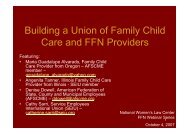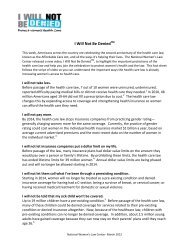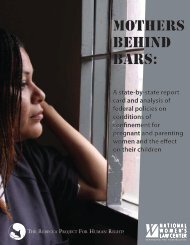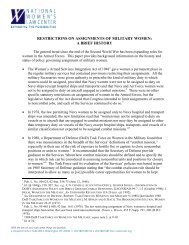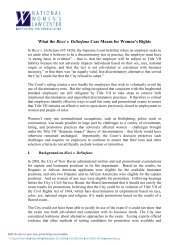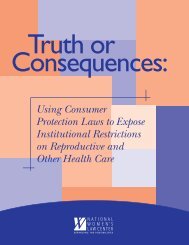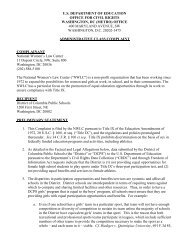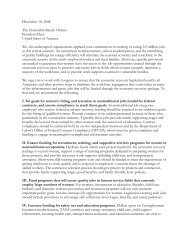Teen Pregnancy - National Women's Law Center
Teen Pregnancy - National Women's Law Center
Teen Pregnancy - National Women's Law Center
You also want an ePaper? Increase the reach of your titles
YUMPU automatically turns print PDFs into web optimized ePapers that Google loves.
Two Sides of the Same Coin:<br />
<strong>Teen</strong> <strong>Pregnancy</strong> Prevention and Dropout Prevention<br />
<strong>Teen</strong> pregnancy prevention and dropout prevention go hand-in-hand. That’s because girls who get<br />
pregnant as teenagers are less likely to graduate from high school, and some girls who drop out of<br />
school are more likely to get pregnant as teenagers. Schools that are serious about reducing the<br />
incidence of teen pregnancy and about improving their school’s graduation rates must recognize this<br />
connection and take appropriate, aggressive steps to address both problems effectively.<br />
The Link Between <strong>Pregnancy</strong> and Dropout:<br />
<strong>Pregnancy</strong> and parenting responsibilities<br />
significantly affect girls’ graduation rates. For<br />
example, in a recent Gates Foundation survey of<br />
dropouts, close to one-half of the girls surveyed<br />
said that becoming a parent was a factor in their<br />
decisions to leave school; over one-third said that<br />
it played a major role in their decisions. 6 And<br />
over one-third of the boys said it was a factor for<br />
them; with 19 percent saying it played a major<br />
role. 7 So preventing pregnancy will go a long<br />
way toward improving high school graduation<br />
rates. This is especially so because pregnant and<br />
parenting students often are highly motivated – in<br />
the same survey, those who left school to care for<br />
a family member or because they became a<br />
parent, more than any other group of dropouts,<br />
were “most likely to say they would have worked<br />
harder if their schools had demanded more of<br />
them and provided the necessary support.” 8<br />
Facts about <strong>Teen</strong> <strong>Pregnancy</strong><br />
and Birth Rates:<br />
<strong>Teen</strong> pregnancy rates in the U.S are<br />
distressingly high, far higher than in most<br />
other developed countries. 1<br />
Overall, 16 percent of teen girls will have a<br />
baby before they turn 20. 2<br />
For girls of color: 53 percent of Latina and 51<br />
percent of African American teen girls will<br />
become pregnant at least once before age 20. 3<br />
<strong>Teen</strong> birth rates are high too. Between 2005<br />
and 2006, for the first time in 15 years, the<br />
overall teen birth rate rose. 4<br />
Again, this is especially true for girls of color.<br />
The birth rates of teen girls rose for African<br />
Americans (5% increase), Native Americans<br />
(4% increase), and Latinas (2% increase). 5<br />
Pregnant and parenting students’ chances of success are harmed by a lack of support from their schools,<br />
active discouragement by school personnel, outright discrimination and stigmatization, and inferior<br />
alternative education programs. Such treatment likely violates Title IX of the Education Amendments<br />
of 1972: Title IX is the civil rights law that prohibits all federally funded educational programs and<br />
activities from discriminating based on sex, which includes pregnancy or parenting status.<br />
Not only is it illegal, but such treatment also decreases pregnant and parenting students’<br />
engagement in school, increasing the risk that they will drop out. Even if students overcome these<br />
barriers while pregnant or parenting one child, staying in school can be even more challenging for<br />
teenagers who have a second or subsequent pregnancy. 9
Additionally, some girls who drop out are more likely to get pregnant as teenagers than girls who<br />
stay in school. 10 And the children of dropouts are more likely to drop out of school themselves,<br />
extending the negative consequences of dropping out to future generations. 11 Taking steps to<br />
keep girls engaged in school and to get them to graduation day will also help to prevent students<br />
from getting pregnant and starting families prematurely, before they have reached their<br />
educational goals.<br />
UUSchools Can – And Must – Do More<br />
There are numerous steps schools can take to prevent teen pregnancy and thereby keep<br />
girls in school, including:<br />
Provide students with comprehensive, medically accurate and age-appropriate sex<br />
education that includes information about contraception, abstinence, and how to avoid<br />
sexually transmitted diseases.<br />
Abstinence-only programs have not been effective 12 and provide inaccurate and<br />
misleading information about contraception. 13<br />
Comprehensive sex education programs stress the importance of abstinence but also<br />
give teens the full range of accurate information they need to make responsible, healthy<br />
decisions. Numerous studies have found certain comprehensive sex education<br />
programs to be highly effective in delaying initiation of sex, reducing number of sexual<br />
partners, reducing incidence of unprotected sex and increasing condom usage among<br />
American youth, among other positive results. 14<br />
Facilitate students’ access to contraception.<br />
Some schools offer school-based health centers; others have partnered with nearby<br />
clinics to help with in-school support and education and to provide free reproductive<br />
and contraceptive health services and counseling at the clinic site.<br />
Make sure students who already have become parents get access to effective<br />
contraception to prevent subsequent pregnancies.<br />
Help parents to speak with their children about sex, love, relationships and preventing<br />
pregnancy.<br />
Many parents do not know where to start. Schools can provide culturally appropriate<br />
information, tools and opportunities for parents to improve communication with their<br />
children.<br />
Implement strong dropout prevention measures.<br />
Girls who are engaged in school, who do well academically, who are involved in sports<br />
or other school activities – or who have strong goals for the future and believe that they<br />
<strong>National</strong> Women’s <strong>Law</strong> <strong>Center</strong>, Washington, D.C., June 2009<br />
www.nwlc.org<br />
Page 2
will achieve those goals – are less likely to end up pregnant than those who are<br />
disengaged or who drop out. Serious efforts to keep girls in school will help to keep<br />
them from getting pregnant, including mentoring and tutoring, encouraging<br />
participation in school activities, supporting their access to quality career and technical<br />
education programs that prepare them for promising jobs, and helping with goal setting<br />
and career exploration.<br />
Schools also should help students who do get pregnant to stay in school and graduate.<br />
For students who do get pregnant, there are many steps schools can take to keep them<br />
from getting pregnant again and to keep them in school. For more information, go to<br />
www.nwlc.org/pregnantandparentingstudents.<br />
UUConclusion - Congress Must Help Make This Happen:<br />
Congress should pass the Real Education About Life (REAL) Act (S. 611/H.R. 1551), which<br />
would authorize the first federal funding stream dedicated to providing comprehensive,<br />
medically-accurate, age-appropriate sex education to our youth. For more information about the<br />
REAL Act, go to: UUhttp://www.nwlc.org/pdf/realact09.pdfUU.<br />
For more information on any of these issues, please contact the <strong>National</strong> Women’s <strong>Law</strong> <strong>Center</strong> at<br />
UUinfo@nwlc.orgUU.<br />
_________________<br />
References<br />
1<br />
Jacqueline E. Darroch et al., Guttmacher Institute, <strong>Teen</strong>age Sexual and Reproductive Behavior in Developed<br />
Countries: Can More Progress Be Made?, OCCASIONAL REPORT 3 (2001), available at<br />
UUhttp://www.guttmacher.org/pubs/eurosynth_rpt.pdfUU.<br />
2 The <strong>National</strong> Campaign to Prevent <strong>Teen</strong> and Unplanned <strong>Pregnancy</strong>, Policy Brief: Racial and Ethnic Disparities in<br />
<strong>Teen</strong> <strong>Pregnancy</strong> (July 2008), available at<br />
UUhttp://www.thenationalcampaign.org/resources/pdf/Briefly_PolicyBrief_RacialEthnicDisparities.pdfUU.<br />
3 Id.<br />
4 Id.<br />
5<br />
Id.<br />
6 Peter D. Hart Research Associates, Gates Foundation Dropouts Survey, (Sep./Oct. 2005) (finding that 47% of<br />
female dropouts surveyed said that becoming a parent was a factor in their decisions to drop out and 33% said it was<br />
a major factor).<br />
7 Id. (finding that 38% of male dropouts said that becoming a parent was a factor in their decisions to drop out).<br />
8 Bridgeland et al., The Silent Epidemic: Perspectives of High School Dropouts 6 (Civic Enterprises, 2006).<br />
9<br />
Studies have determined that school-aged teen moms who have two or more teen births are less likely to complete<br />
school and more likely to have lower levels of educational attainment that teens who have one or no births. J.<br />
Manlove, C. Mariner, & A. Romano, Positive Outcomes among School-Age Mothers: Factors Associated with<br />
Postponing a Second <strong>Teen</strong>age Birth, Child Trends<br />
(1997); D. Scott-Jones, Educational Levels of Adolescent Childbearers at First and Second Births, 99:4 American<br />
Journal of Education, at 461-480.<br />
10 Jennifer Manlove, The Influence of High School Dropout and School Disengagement on the Risk of School-Age<br />
<strong>Pregnancy</strong>, 8 Journal of Research on Adolescence 201 (1998).<br />
11 Id.<br />
12<br />
The overwhelming weight of the evidence fails to support abstinence-only programs. See, e.g., SIECUS, What<br />
the Research Says . . . (Oct. 2007), available at http://www.siecus.org/policy/research_says.pdf<br />
<strong>National</strong> Women’s <strong>Law</strong> <strong>Center</strong>, Washington, D.C., June 2009<br />
www.nwlc.org<br />
Page 3
(citing a number of studies); see also Rebecca A. Maynard et al., Mathematica Policy Research, First-Year Impacts<br />
of Four Title V, Section 510 Abstinence Education Programs (2005), available at<br />
http://aspe.hhs.gov/hsp/05/abstinence/report.pdf.<br />
13 Staff of the House Comm. On Government Reform, Special Investigations Division, 108 th Cong., Report on the<br />
Content of Federally Funded Abstinence-Only Education Programs (2004) (also known as the “Waxman Report”).<br />
14 Sue Alford, Fact Sheet: Advocates for Youth, Science & Success: Programs that Work to Prevent <strong>Teen</strong><br />
<strong>Pregnancy</strong>, HIV and Sexually Transmitted Infection (2007), available at<br />
http://www.advocatesforyouth.org/PUBLICATIONS/factsheet/fssti.htm.<br />
<strong>National</strong> Women’s <strong>Law</strong> <strong>Center</strong>, Washington, D.C., June 2009<br />
www.nwlc.org<br />
Page 4




